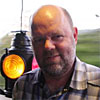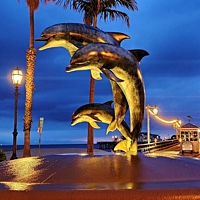Home » Jazz Articles » Live Review » Monterey Jazz Festival 2014
Monterey Jazz Festival 2014
The Monterey Jazz Festival has managed to reflect the vastness of jazz, from its most accessible and party-ambience-suitable to at least relative abstraction and outer limits.
—Josef Woodard
Monterey County Fairgrounds
Monterey, CA
September 19-21, 2014
Working the Numbers, and Young People Going Deep
Numbers worked in mysterious, seemingly synchronistic ways at this year's Monterey Jazz Festival, which celebrated its 57th anniversary year partly by also respectfully toasting the 75th anniversary of the mighty Blue Note Records label. Of course, music and numbers enjoy a tight relationship, along with a certain numerological fixation, and that tidy numerical palindrome—57/75—gained further number-ized traction when the all-star gathering of young Blue Note artists opened its feisty set with the title tune of Wayne Shorter's Speak No Evil, certainly one of the landmark records in the Blue Note catalogue, and coincidentally was released 50 years ago.
This boldly talented pack of Blue Note-linked young lions went by the collective name Our Point of View, which could as easily been dubbed Our Points of View, for the respective individual thrusts of the artists—Robert Glasper, Ambrose Akinmusire, Marcus Strickland, Lionel Loueke, Derrick Hodge and Kendrick Scott—and also the multiple points of historicist and modernist, and populist views. New Blue Note head, hip pop producer Don Was, perched happily with post-hippie beatitude off to stage left, glowing with satisfaction at the finery and forward thinking nature of this representing faction of the label's current roster.
Just as Blue Note plays a formidable role in jazz history, so goes the Monterey festival, surely in the elite top ten list of jazz festivals in the world, and one which gives a healthy overview of what's happening at a given time in jazz—while reflecting the importance and informing echoes of the past. During director Tim Jackson's long and notable reign—has managed to reflect the vastness of jazz, from its most accessible and party-ambience-suitable to at least relative abstraction and outer limits.
Speaking of relative abstraction, for this listener, the high point of the weekend came with trumpeter-bandleader-new jazz avatar Ambrose Akinmusire's stunning set on the Night Club stage, his concepts and band sound honed by a few years investment of time and creative energy by now. No doubt, a personal anecdotal connection deepened the experience: I first heard Akinmusire on this stage, four years ago, before the release of the first of his now two Blue Note albums, When the Heart Emerges Glistening, and I had one of those rare, senses-seizing "who/what is that?!" epiphanies. Fast forward to 2014, and the release of another innovative, genre-defiant album, "the imagined saviour is far easier to paint," from which much of his Monterey set was derived. With his gymnastic register-leaping, painterly half-valve tones and other sonic nuances easily in reach, Akinmusire can sound virtuosic and emotional vulnerable, by turns, a rare blend of attributes, and brings to each solo a kind of conceptual approach. There is something uniquely intellectual yet visceral, bold yet sensuous, fluid character to the music Akinmusire is creating, a music grounded in jazz but headed to whereabouts not quite known or named.
Monterey itself has such rich deposits of jazz history to draw on that history often repeats and/or reframes itself on these grounds. This year, for instance, saw the return of a significant Monterey artist, Charles Lloyd, whose 1966 performance resulted in the best-selling album Forest Flower, and erected bridges between a pop audience and the stuff of jazz, while advancing the name and hipness quotient of the Monterey Jazz Festival. Lloyd, who was officially this year's "Showcase Artist" and what a radio pundit called a festival "poster boy," last played here in 2006, the 40th anniversary of the "Flower" phenom, and why they didn't wait two more years to register the 50th seems odd. But this is a luminous period for Lloyd, who is set as NEA Jazz Master for 2015, and has been scooping up plaudits and honors in his itinerant wake.
Lloyd, looking and sounding sharp at age 76, appeared in the smaller venues with his trio Sangam and in a duet with his newest pianist ally, Gerald Clayton, a flexible power broker at the keys, and a good new right hand pianist for Lloyd. On Sunday evening, when he hit the familiar big arena stage with his band, with pianist Jason Moran, bassist Reuben Rogers and drummer Eric Harland (one of the finest of the many Lloyd outfits over the years), the band's presence felt here and now, but with plenty of then stirred in: they did satisfy the crowd's desire to hear "Forest Flower," although Lloyd rarely plays the tune anymore, and the simmering extended end coda section sounded more subdued, more like heading into the sunset rather than bursting with promise at sunrise.
Digging yet deeper, and wider, in Monterey archives, the annual festival-commissioned piece this year went to the refined and clean-burning pianist Aaron Diehl, whose twenty-minute, three-part suite "The Three Streams of Expression" paid tasteful tribute to one of his heroes, pianist John Lewis, who was a festival director here for a quarter century. Seamless blending elements of plush-lined bop, Baroque-ish comportment and counterpoint, and controlled melancholic waves, Diehl's new piece made a strong impression, and one with unabashedly clear and binding lines leading back to the influence of his subject.
Among other detectable trends in 2014, this festival program was bolstered by strong, individualistic female singers, moving above and beyond the usual standards trade. The smart short list of dazzling singers started at the start, with the festival-opening arena set by the much-acclaimed—and very rightly-acclaimed —young "old soul" wonder, Cecile McLorin Salvant. Abetted by a sharp and sharply-arranged trio, featuring pianist Diehl, Salvant shuttled from the early Friday night arena spotlight over to the more intimate—and fully-packed—Night Club venue to show more of what the entrancing 25-year-old is made of. She is your not-so-basic classically-trained, subtly theatrical, soulful and swinging, and yes, Billie Holiday and Thelonious Monk-inflected, Bessie Smith-obsessed vocalist with something new and history-wrapped to offer us.
From a very different musical corner, Becca Stevens is, quite simply, a folk-jazz-musical force to reckon with, easy categorizations be damned. She is coming out of Joni Mitchell's innate jazz-flavored inventiveness and cliché-dodging adventurism—the shifting meters and unexpected chordal twists—and she made the unabashed Joni connection clear by ending her set in the Dizzy's Den venue with a righteous version of "Help Me." But Stevens has her own kind of language and sound to offer as a singer-songwriter who also relishes the weave of an ensemble (she was joined by a mostly acoustic trio) and painterly use of dynamics and words-music interplay.
As testament to Stevens' versatility and artistic reach, she also appeared with Akinmusire (singing the sighingly poignant song she co-wrote on his latest album,Our Basement) as well as part of Billy Childs' loving and invitingly chamber-esque tribute project to Laura Nyro late on Saturday night.
In quite a different corner and set of cultural reference points entirely, the Garden Stage came alive in strange and wonderful ways on Sunday afternoon, courtesy of the fascinating South Korean vocalist Youn Sun Nah, who has been slowly working her way around the world with the help of her fine albums on ACT and an expanding touring map and festival circuitry. She is a petite and polite woman, whose shy between-song speech can be startling for audiences, as the polar opposite of her commanding power and experimental charisma in the heat of a song. Said songs range from the opening cover of Nine Inch Nails' "Hurt," in a brooding bluster of an arrangements, to the punkish growl of her take on "Ghost Riders in the Storm" to close a set which inspired a palpable ecstatic air in the crowd. She also cooed a rubato rendering of "My Favorite Things," with thumb piano, and handily maneuvered the tricky, odd meter lines in songs by her Al Di Meola-esque acoustic guitarist, Ulf Wakenius, and brought fresh ideas and eccentric intensity to reworked folk songs from Scotland to Korea.
There were lesser moments in the festival flow, of course. A late Saturday night set by the Roots—America's favorite late night talk show band, and a great American band, period—was a high-energy blast of goodness, but it felt out-of-place in the "jazz portion" of the programming, better suited to the traditional groove zone of the Saturday or Sunday afternoon schedule. Michael Feinstein cooked up his Sinatra-esque suavity and good humor to close the festival on Sunday night, but was a bit too far from jazz syntax and swing (swingtax?), proper, and too close to the effect of a piano bar-rista for comfort.
Standards tend to naturally rise at the Monterey festival, especially for us long-timers (going on 27 consecutive years for this hopeless pilgrimage-maker) tickled by profound and strange and otherwise notable memories on these hallowed, dusty rustic fairgrounds. On the whole, though, the 57/75 year was one for the books, particularly regarding the issue of young artists carving out new places and patois in jazz.
Tags
Live Reviews
Josef Woodard
Monterey Jazz Festival
United States
California
Santa Barbara
Wayne Shorter
Robert Glasper
ambrose akinmusire
Marcus Strickland
Lionel Loueke
Derrick Hodge
Kendrick Scott
charles lloyd
Gerald Clayton
jason moran
Reuben Rogers
Eric Harland
Aaron Diehl
Cecile McLorin Salvant
Billie Holiday
Thelonious Monk
Becca Stevens
Joni Mitchell
Billy Childs
Youn Sun Nah
Al Di Meola
Ulf Wakenius
PREVIOUS / NEXT
Support All About Jazz
 All About Jazz has been a pillar of jazz since 1995, championing it as an art form and, more importantly, supporting the musicians who make it. Our enduring commitment has made "AAJ" one of the most culturally important websites of its kind, read by hundreds of thousands of fans, musicians and industry figures every month.
All About Jazz has been a pillar of jazz since 1995, championing it as an art form and, more importantly, supporting the musicians who make it. Our enduring commitment has made "AAJ" one of the most culturally important websites of its kind, read by hundreds of thousands of fans, musicians and industry figures every month.






















